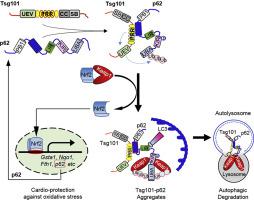Redox Biology ( IF 11.4 ) Pub Date : 2020-02-06 , DOI: 10.1016/j.redox.2020.101453 Shan Deng 1 , Kobina Essandoh 2 , Xiaohong Wang 2 , Yutian Li 2 , Wei Huang 3 , Jing Chen 4 , Jiangtong Peng 5 , Ding-Sheng Jiang 6 , Xingjiang Mu 2 , Chenran Wang 7 , Tianqing Peng 8 , Jun-Lin Guan 7 , Yigang Wang 3 , Anil Jegga 4 , Kai Huang 5 , Guo-Chang Fan 2

|
Currently, most antioxidants do not show any favorable clinical outcomes in reducing myocardial ischemia-reperfusion (I/R) injury, suggesting an urgent need for exploring a new regulator of redox homeostasis in I/R hearts. Here, using heart-specific transgenic (TG) and knockdown (KD) mouse models, tumor susceptibility gene 101 (Tsg101) is defined as a novel cardiac-protector against I/R-triggered oxidative stress. RNA sequencing and bioinformatics data surprisingly reveal that most upregulated genes in Tsg101-TG hearts are transcribed by Nrf2. Accordingly, pharmacological inhibition of Nrf2 offsets Tsg101-elicited cardio-protection. Mechanistically, Tsg101 interacts with SQSTM1/p62 through its PRR domain, and promotes p62 aggregation, leading to recruitment of Keap1 for degradation by autophagosomes and release of Nrf2 to the nucleus. Furthermore, knockout of p62 abrogates Tsg101-induced cardio-protective effects during I/R. Hence, our findings uncover a previously unrecognized role of Tsg101 in the regulation of p62/Keap1/Nrf2 signaling cascades and provide a new strategy for the treatment of ischemic heart disease.
中文翻译:

Tsg101 正向调节 P62-Keap1-Nrf2 通路以保护心脏免受氧化损伤。
目前,大多数抗氧化剂在减少心肌缺血再灌注 (I/R) 损伤方面没有显示出任何有利的临床结果,这表明迫切需要探索一种新的 I/R 心脏氧化还原稳态调节剂。在这里,使用心脏特异性转基因 (TG) 和敲低 (KD) 小鼠模型,肿瘤易感基因 101 (Tsg101) 被定义为针对 I/R 触发的氧化应激的新型心脏保护因子。RNA 测序和生物信息学数据出人意料地揭示了 Tsg101-TG 心脏中大多数上调的基因是由 Nrf2 转录的。因此,Nrf2 的药理学抑制抵消了 Tsg101 引发的心脏保护作用。从机制上讲,Tsg101 通过其 PRR 结构域与 SQSTM1/p62 相互作用,并促进 p62 聚集,导致 Keap1 被自噬体降解并释放到细胞核中。此外,p62 的敲除消除了 I/R 期间 Tsg101 诱导的心脏保护作用。因此,我们的研究结果揭示了 Tsg101 在调节 p62/Keap1/Nrf2 信号级联中的先前未被认识的作用,并为缺血性心脏病的治疗提供了新的策略。


























 京公网安备 11010802027423号
京公网安备 11010802027423号